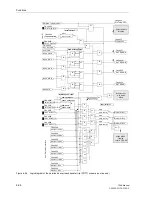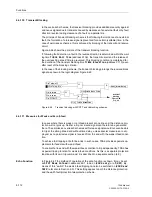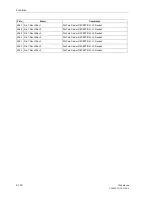
Functions
6-112
7SA6 Manual
C53000-G1176-C156-2
6.6.1.10 Transient Blocking
In the overreach schemes, the transient blocking provides additional security against
erroneous signals due to transients caused by clearance of an external fault or by fault
direction reversal during clearance of a fault on a parallel line.
The principle of transient blocking scheme is that following the incidence of an external
fault, the formation of a release signal is prevented for a certain (settable) time. In the
case of permissive schemes, this is achieved by blocking of the transmit and receive
circuit.
Figure 6-66 shows the principle of the transient blocking function.
If, following fault detection, a fault in the reverse direction is determined within the wait-
ing time
TrBlk Wait Time
(address
2109
), the transmit circuit and the release of
the overreaching zone Z1B are prevented. This blocking condition is maintained for
the duration of the transient blocking time
TrBlk BlockTime
(address
2110
) even
after reset of the blocking criterion.
In the case of the blocking scheme, the transient blocking prolongs the received block
signal as shown in the logic diagram Figure 6-63.
Figure 6-66
Transient blocking with POTT and Unblocking schemes
6.6.1.11 Measures for Weak and Zero Infeed
In cases where there is weak or no infeed present at one line end, the distance pro-
tection will not pick up. Neither a trip nor a send signal can therefore be generated
there. The permissive overreach schemes with release signals would not even be able
to trip at the strong infeed end without time delay, unless special measures are em-
ployed, as no permissive signal is received from the end with the weak infeed condi-
tion.
To achieve fast tripping at both line ends in such cases, 7SA6 provides special sup-
plements for feeders with weak infeed.
To enable the line end with the weak infeed condition to trip independently, 7SA6 has
a special tripping function for weak infeed conditions. As this is a separate protection
function with its own trip command, it is described in a separate section (6.9).
Echo Function
In Figure 6-67 the method of operation of the echo function is shown. It may be set
with
FCT Weak Infeed
in address
2501
to be on (
ECHO only
) or off (
OFF
). By
means of this “switch” the weak infeed tripping can also be switched on (
ECHO and
TRIP
, refer also to Section 6.9). This setting applies to both the distance protection
and the earth fault protection teleprotection scheme.
Dis. forward
&
Dis. PICKUP
2109
TrBlk Wait Time
2110
TrBlk BlockTime
Dis Telep. off
>Dis.Telep. Blk
≥
1
&
transient
blocking
Figure 6-58
or 6-60
T
T
≥
1
Dis. reverse
Alarm Delay
4003
Summary of Contents for siprotec 7SA6
Page 2: ...Siemens Aktiengesellschaft Book No C53000 G1176 C156 2 ...
Page 18: ...xviii 7SA6 Manual C53000 G1176 C156 2 ...
Page 32: ...Introduction 1 14 7SA6 Manual C53000 G1176 C156 2 ...
Page 82: ...Hardware and Connections 2 50 7SA6 Manual C53000 G1176 C156 2 ...
Page 119: ...SIPROTEC 4 Devices 4 25 7SA6 Manual C53000 G1176 C156 2 Figure 4 20 CFC Logic example ...
Page 190: ...Configuration 5 62 7SA6 Manual C53000 G1176 C156 2 ...
Page 652: ...Installation and Commissioning 8 78 7SA6 Manual C53000 G1176 C156 2 ...
Page 724: ...Technical Data 10 56 7SA6 Manual C53000 G1176 C156 ...
Page 800: ...Appendix A 76 7SA6 Manual C53000 G1176 C156 2 ...
Page 866: ...Appendix B 66 7SA6 Manual C53000 G1176 C156 2 ...
















































